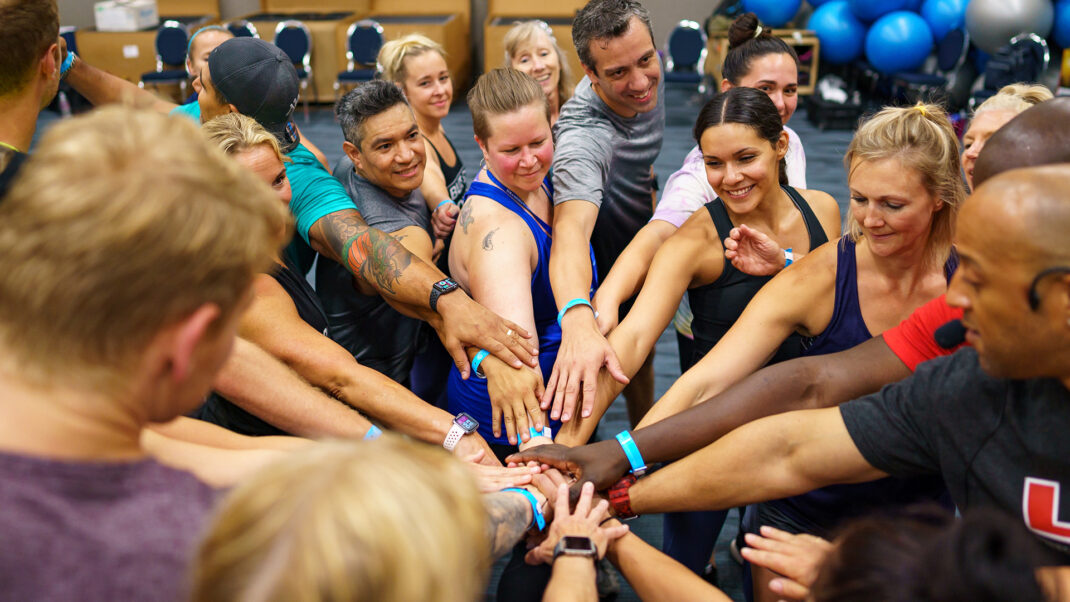IDEA World Fitness Convention™ Memories
Congratulations on celebrating 30 years! I attended the first IDEA convention in San Diego in 1984, and I have attended many IDEA events since. The speakers and leaders have been fabulous. I began [working] with the YMCA in 1969, teaching group fitness, and I retired in 2009 as a YMCA director. I continue to teach aqua exercise and Pilates 5 hours per week. Throughout my career, IDEA and ACE have been at the core of YMCA trainings. I was in the first certification class for ACE group instructor, and I continue to recertify every 2 years. The knowledge I have gained and used is so vast. I have many stories to tell from the last 42 years, but will only say thank you for being on the journey with me.
Mary Morrison
Bonita Springs, Florida
As usual, the IDEA World Fitness Convention was a smashing success. I appreciate your giving the IDEA Jack LaLanne Award each year on behalf of Jack. I guess I’ll have to keep practicing my push-ups to do them again next year. Claire here in the office said she will do a few with me every day to keep me in shape! Thank you again for keeping Jack’s legacy alive.
Elaine LaLanne
BeFit Enterprises
Morro Bay, California
Thank you for asking me to present again for IDEA World! It was, as always, a wonderful experience. The growth and development of the presenters, as well as the innovations in the expo hall, were truly notable. I really think there is a shift occurring: the presentations were more unified, yet extremely diverse. I had time to watch about nine sessions—ranging from movement classes to lectures. Really super stuff! As always, thank you for your hard work. It’s certainly an amazing transformation that IDEA is continuously creating.
Sue Hitzmann
Founder and CEO, Longevity Fitness
Inc., The MELT® Method
New York, New York
What an amazing job you did to celebrate your 30th anniversary at IDEA World Fitness! There was such positive energy around the convention. The July–August edition of IDEA Fitness Journal really helped highlight IDEA’s journey and the wonderful members you have on board. I look forward to seeing what you guys come up with next! Keep up the wonderful work!
Justin Price, MA
Creator, The BioMechanics Method
San Diego, California
As I watched the last 30 years of IDEA on the big screen [during the IDEA World Fitness Opening Ceremonies], I sobbed. I remembered how scared I was getting my MS diagnosis; falling quite a bit; losing my sight three times; and worried—so worried that I would never walk again, let alone teach aerobics. As I watched, I felt so lucky that I’d had the opportunity to be a piece of such a big purpose in this life: to help and inspire others to be. Thank you for providing such bright, talented, energetic presenters. Their knowledge is insurmountable. It’s been an amazing journey. Thank you, IDEA, for being such a part of my life.
Cea Cohen
Speaker/Fitness Instructor
Beavercreek, Ohio
Thank you for the big stage presentation and for including the Challenged Athletes Foundation® in the IDEA World Fitness Convention Opening Ceremonies. We have had many folks tell us they saw the event and say how much it meant to them. We were honored to be part of this special celebration of 30 years. You have a lot to be proud of.
Nancy A. Reynolds
Senior Director of Business
Development, Challenged Athletes
Foundation
San Diego, California
Ah, yes. I remember the ill-fated 1991 Pittsburgh IDEA conference. One of my recollections is of the hotel putting out a few pastries for Saturday breakfast—not believing that IDEA attendees do get up for 7:00 am sessions and do want real food. Sunday morning, we found that IDEA staff had gone to the produce markets and procured thousands of bananas and bagels, which they handed out gratis. Despite the problems, all of the sessions were informative and inspiring, just as we always expect—and get—from IDEA.
Lucinda McGrew Dyjak
IDEA member since 1987
Dairy-Acne Link
I would like to draw attention to an inaccuracy in the article “Recipe for Great Summer Skin” [June 2012]. The author references the work of Loren Cordain, MD, when she states that “long-held beliefs that chocolate, fatty foods and dairy cause acne have been largely disproved.” This passage is from work published in 2005. An article authored by Cordain, “Dietary Implications for the Development of Acne: A Shifting Paradigm,” was subsequently published in the U.S. Dermatology Review 2006. The more current article contains a section, “Dairy Products and Acne: New Findings,” which states that “a high milk diet . . . caused insulin resistance . . . [which] may promote acne via the hormonal cascade.” Cordain also states, in a Q & A on the Paleo Diet website, that “in large epidemiological studies published by researchers from the Harvard School of Public Health, cow milk drinking has been shown to be strongly associated with acne.” This work is dated March 29, 2012. With the general public and fitness industry members constantly being bombarded with conflicting information on dietary matters, it is vitally important that the most current works of researchers and authors be cited when information is presented on a topic.
Bailey Leonard, MS, NASM-CPT
Glen Mills, Pennsylvania
The author responds: The author wishes to thank Bailey Leonard for the comments regarding the role of dairy in the causation of acne. In an excellent review by Davidovici & Wolf (2010), the collective evidence that dairy causes acne was found to be slim and, as a result, the review authors concluded that dairy products should not be removed from the diet to prevent acne. In my article, I cite a 2005 reference by Cordain; little has changed since publication of this article.
Some evidence suggests that dairy products may induce a cascade of events that increase glycemic load and hyperinsulinemia. Cordain (2006) discusses the possibility that dairy products induce acne through hyperinsulinemia and mitigation of IGF-1 and, as evidence, cites a small study of preadolescent boys who were given a high-milk diet for a week. The pathogenic hypothesis put forth that IGF-1 induction via the consumption of milk products mediates acne eruptions is plausible, but is not supported by the peer-reviewed scientific evidence, and, while compelling, the single-study results by no means reflect the body of data (Pappas 2009).
Further, “Western” diets are characterized by high-glycemic rich foods that include foods other than dairy. As discussed in my article, consumption of sugary foods is linked to acne. Cordain (2006) clearly states that additional studies regarding the effects of milk on acne pathogenesis need to be conducted in a controlled manner in which dairy products are included or excluded.
Leonard refers to studies conducted by the Harvard School of Public Health. Although mentioned on the Cordain website in 2010, the actual studies were published in 2005, 2006 and 2008 (Adebamowo et al. 2005, 2006, 2008). The purpose of these studies was to determine the association between acne and dietary intake. These studies relied on food frequency questionnaires administered in the mid to late 1990s, and responses showed a positive association between intake of milk and acne. Reliance on self-reported consumption is problematic, however; recollection of true consumption is often flawed, and results frequently do not reflect actual intake. Moreover, Adebamowo et al. (2008) stated that [the researchers] did not take into account lifestyle or genetic factors that influence acne. Because of these methodological issues, the American Academy of Dermatology (AAD) was reluctant to recommend dietary restrictions, citing lack of convincing evidence (Pappas 2009; Strauss et al. 2007).
Leonard correctly states that there is an abundance of conflicting dietary information and that one must cite the most recent research. To this point, I stand by my statement and provide additional and more current references that reiterate the point made in my original statement, as supported by the 2005 Cordain reference. I believe Leonard provides an excellent example of why one must use caution when relying on information contained in promotional websites that do not list specific peer-reviewed scientific references to support their opinions presented as fact. Further, many websites often interpret individual study results as “cause” rather than “association” and fail to consider the body of data. Careful interpretation is paramount to reducing misinterpretation of complex dietary data and necessary to provide our clients with the best science has to offer.
Martina Cartwright, PhD
References
Balanced, Specific Programs Foster Performance Gains
I’ve been a member of IDEA for many years and have been in the fitness profession for some 30 years. I’ve seen fads and gimmicks come, go and return. Some innovations have been groundbreaking, some laughable at best. I have grown more concerned over the past few years with the direction in which I see the industry moving—driven no doubt, by Baby Boomers and Gen Xers who want to prove that age is just a number.
My concern stems from what seems to be a lack of acceptance of some basic “rules” that guide the adaptations the human body goes through as a result of exercise. The characteristic I am most concerned with is “specificity of exercise.”
I work in a large JCC, with about 20 personal trainers. Exercise programs and equipment such as Group Power®, BodyPump™, TRX® Suspension Training®, kettlebells and various balance devices all have their place in a well-rounded fitness program. However, having clients stand on BOSU® Balance Trainers and do squats while performing dumbbell biceps curls will not enhance strength and preserve muscle mass in the same way or to the extent that simple, old-fashioned strength training will. Why? Because the body cannot devote its resources to momentarily exhausting a muscle or muscle group if it is expending energy to stabilize or balance.
I have spoken with many members of our facility who, in spite of performing almost an hour of vigorous cardio exercise 5 or 6 days a week and engaging in some of these “multiplanar, multidimensional” workouts, have stopped losing weight—or more accurately—body fat because the routines they are doing are not providing the overload required to stimulate and maintain muscle growth and maintenance.
All of these tools should be combined to form a balanced exercise program. It’s when we try to reinvent the wheel that we do ourselves and our clients a disservice. At age 61, I can outlift and outwork people half my age, thanks in great part to sensible strength training and to the fact that I’ve followed the basic principles that many trainers have forsaken in an attempt to be creative and come up with “the next big thing.”
Robert M. Gaudio, ACE-Certified
Recreation & Wellness Operations
Director, Mandell JCC, Zachs Campus
West Hartford, Connecticut
How Do You Build a Better Breakfast?
I used to travel as an international fitness presenter, and I ate breakfast in many different countries. When I read the article “Build a Better Breakfast: A Global Sampling” in IDEA Fitness Journal [Food for Thought, June 2012], I thought of how my husband and I have changed our morning routine. He was born a German citizen and immigrated to the U.S. His mom cooked breakfast every day.
He and I went back to Germany and traveled to Asia many times while I was working. The morning meal we ate in those countries usually lasted us through the day, with a light snack in the afternoon and a sensible evening meal. Commonly [for breakfast], we saw yogurts, granolas, fruit, vegetables, meats with brochen (bread) in Germany, and in Asia we often saw soup, rice, fish, vegetables and salads, more resembling an American dinner.
I used to eat cereal 5 days per week, with a larger egg meal with pancakes on the weekends. Now my husband and I typically eat one of two breakfast menus and have basically eliminated cereal/processed flour as a start to our day. We have tons of energy.
Breakfast A: sautéed vegetables (kale, mushrooms, squash, broccoli, etc.) with wild brown rice (precooked) and/or black beans and sometimes a poached egg on top. It doesn’t take much time to make. Breakfast B: plain, organic yogurt and fresh berries (blueberries, strawberries, blackberries) or sliced fruit, with nuts or a grain or homemade granola on top. Maybe these ideas can assist Americans in making a healthier choice in the morning.
Theresa Merz, BS, MES, ACE Certified
Owner, Fitness Works
Penn Valley, California
I was born and raised in the U.S., but I have taken on a more Asian way of eating. I teach fitness classes or do my own workout every morning, so I need something nourishing and light that will last. I eat miso soup every day for breakfast. It consists of carrots, celery, burdock root, shitake mushrooms, green onion, garlic, ginger, turmeric, brown rice, adzuki bean miso and fish. I always add a sea veggie, either wakame or kelp. The soup supplies protein, good fat, whole carbs, antioxidants and probiotics. It digests easily, gives me the energy I need to teach or work out and keeps me satisfied until lunch.
Victoria Cendrowski, MEd
Fitness Supervisor, Community
Education and Recreation, Ann
Arbor Public Schools
Ann Arbor, Michigan





